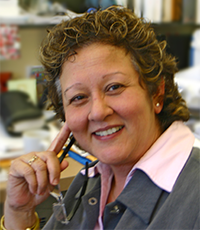Octavius Morgan Distinguished Service Award Recipients: 2013
Named after the first president of the California Architects Board (Board), the Octavius Morgan Distinguished Service Award recognizes individuals who have significantly contributed to the Board’s mission through volunteerism over a period of time. The Board selects award recipients annually. Nominations are accepted from Board members and staff.
The Board relies on volunteers to assist in developing the California Supplemental Examination (CSE) and to serve on many of its committees. Here are the 2013 honorees:
H. Linda Zubiate
San Diego
Linda Zubiate’s fascination with how things are built started when she was very young. Nicknamed "Manos de Hiero" (the "hands of iron") by her dad, she would frequently take things apart, then attempt to put them back together. To the dismay of her parents, it was up to them to do the reassembling.
But from those experiences came opportunity. My dad took my nervous energy and put it to work when he built my mom her dream home from the bottom
up,
she recalls. I followed the whole process, and even did some designing at the age of 14 and then took it into the field with him to build.
After that, there was no stopping me—I knew what my passion was.

Zubiate became the first female in her high school to take a drafting class and later graduated with a very small percentage of women with a Bachelor of Architecture degree from Arizona State University.
From there, she launched a career spanning more than 34 years at the firm of Carrier Johnson + Culture in San Diego, an architectural and interior design practice with satellite offices in Orange County and Los Angeles. The firm specializes in the design of corporate headquarters; higher education and libraries; science and technology; civic centers and public administration buildings; courthouses and corrections facilities; and student housing and mixed-use residential. The professional services of Carrier Johnson + Culture include architecture; interior design; master planning and entitlements; programming and feasibility studies; sustainable design; forensic architecture; strategic branding; and environmental graphics.
Zubiate has served the Board as a CSE Commissioner since 1997 and as a Master Commissioner from 2006 until 2011, when the CSE transitioned from an oral examination format to computer-based. She has been a member of the CSE Commissioner Review and Standard Setting committees, and continues to be involved with CSE development as a subject matter expert. Through these activities, she has contributed approximately 1,000 hours of her time.
For me, volunteering my time has been a way of giving back some of the great knowledge that I’ve been blessed with by my mentors,
reflects
Zubiate. It’s with great satisfaction that I’ve been able to share my knowledge by volunteering for the Board, since it’s the
portal of our profession for young architects. Were it not for the Board, our profession would simply not grow. I have served the Board as a way of
giving back to the profession and, who better than the Board to be the benefactor of all that I have gained from the practice of architecture.
Zubiate also served as board member and mentor for the San Diego chapter of Architecture, Construction and Engineering (ACE). In this role, I had
the privilege to mentor numerous high school students interested in architecture, the educational process, and fundraising efforts to provide
scholarships for them to further their education,
she explains. ACE is a very
beneficial program that I wish had been around when I was searching for answers and support in my younger years.
Zubiate notes that the opportunities she’s had to lead and build numerous high-profile architectural construction projects are part of her
legacy, and among her greatest career accomplishments. The ‘hands of iron’ have truly resulted in some magnificent buildings.
‘Small and simple’ is not in my vocabulary. Through the years, I have had mentors at Carrier Johnson + Culture who have challenged me, and
clients who have become friends through the success of their projects. I have led teams that designed and built Sony Electronics’ North American
headquarters, a 27-story residential high rise, and a Federal courthouse—each project larger and more complex. This is a legacy which I will be
immensely proud of.
Loangle Newsome
Sacramento
As a child riding the bus through downtown Sacramento, Loangle Newsome would examine the buildings, noticing the different colors, shapes, textures and patterns. I
would point out the ones I liked,
he remembers. It was very melodic. I think the bass player in me liked the rhythm and structure. Architecture, like music, can
sometimes be rigid but also flow freely like good jazz.
Newsome believes architecture is a profession comprised of composers and innovators who use their emotions, experience, and applied knowledge to create place.
Architects take parameters that sometimes oppose one another and create an environment where there can be harmony. Like music, architecture has the ability to stir
your emotions if you take the time to appreciate it. It has the power to be art. That is the attraction for me.
Educated at California Polytechnic State University, San Luis Obispo, he is now a project principal with Calpo Hom & Dong Architects in Sacramento, a firm which does
everything in the general practice of architecture except hospitals. My niche is higher education, governmental, adaptive reuse, medical office, data centers, and
industrial,
he says.

Newsome has served the Board as a CSE Commissioner since 2006 and as a Master Commissioner from 2009 until 2011, when the CSE transitioned to a computer-based format. During the final two years the oral format was administered, he attended all six administrations for both Northern and Southern California. Newsome has also served on the CSE Standard Setting Committee while a CSE Commissioner, and continues to be involved with CSE development as a subject matter expert for the computer-based CSE. Through these activities, he has contributed more than 500 hours of his time. He shows an exemplary commitment to examination development through a willingness to be available on short notice and through active recruitment of fellow architects to assist with CSE development.
Architecture is my profession and being an architect is how I define myself,
Newsome explains. As architects we sometimes practice in a vacuum, but by
volunteering with the Board, I get an opportunity to learn from, and interact with other architects. I have met others who share my same concern about the future of the
profession. Being a volunteer gives me insight into the agency responsible for overseeing the practice of architecture in California. It also gives me opportunity to pass
along the knowledge candidates for licensure should possess and helps me remain current with code and practice issues.
Newsome says that career accomplishments are secondary to his personal goal of being a good teacher and mentor. I remember the first day I walked into an office fresh
out of school, a set of plans on my desk and a note saying ‘this is your project.’ I was a little terrified. I asked the person behind me, ‘what do I
do?’ He explained it to me. I have never forgotten that. Yes, I am an architect and principal but I am more than that. The title of architect is a verb describing
my daily engagement. The profession only continues if we are willing to pass on our knowledge. I am privileged to have worked with some great people over the years. Now
at my firm I have been able to mentor talented architects and designers. I am fortunate enough to still practice architecture alongside my principal duties. Being a
mentor enables me to explore the profession I love from a fresh pair of eyes.
And yes, he still plays bass, and is also teaching himself to play the baby grand piano he inherited.
